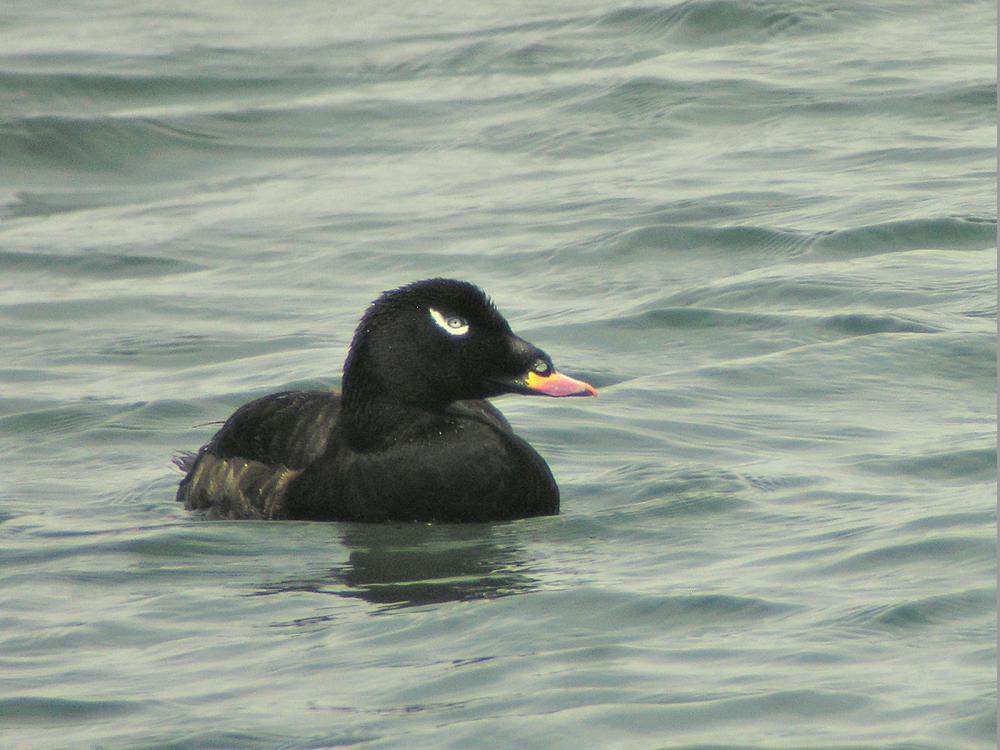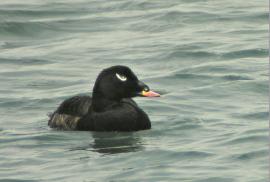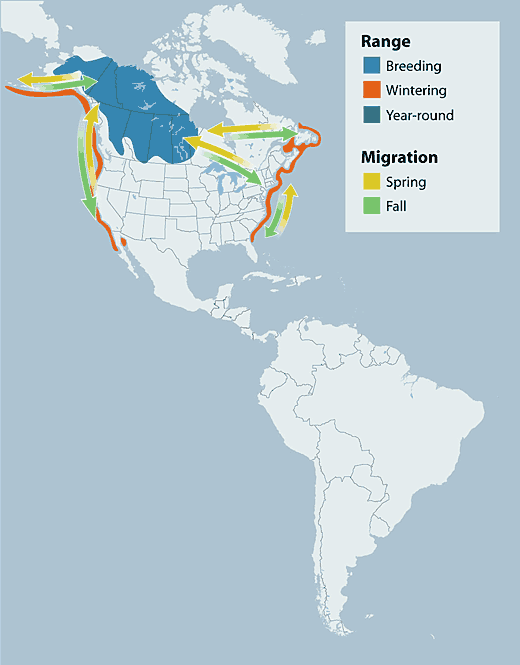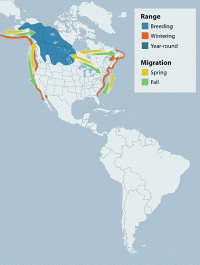Guide to Boreal Birds
This is an in-depth boreal species profile.
What is this?
This species is one of more than 30 birds selected for in-depth profiles. Find out why and see all selected boreal birds »
Overview
The White-winged Scoter of North America (Melanitta fusca deglandi) is one of three subspecies of Melanitta fusca found throughout Holarctic waters, which also includes M. f. stejnegeri of Western Asia and the Velvet Scoter (M. f. fusca) of Eastern Asia and Europe. This large sea duck can be distinguished from the two other scoter species, the Surf (M. perspicillata) and Black Scoter (M. nigra), by its white speculum on a black wing, while the others have a completely black wing. White-wing Scoters, often called White-wings or black ducks, are larger than the other two species and the adult male has a white "slash" below the eye.
During migration, long irregular lines consisting of thousands of White-winged Scoters move southward, just offshore and only a few feet above the waves. The most abundant and widespread of the three scoters-there are over a million in North America-this species feeds chiefly on mollusks, which it collects from mussel beds at depths of 15 to 40 feet (5 to 12 meters). These birds also feed on crabs, starfish, sea urchins, and some fish. Sociable birds, they gather in large flocks or rafts, both to feed and to sleep at night. Like all birds that dive and rest on the sea, they are vulnerable to oil spills.
Description
19-24" (48-61 cm). Male black with bold white wing patches, white crescents around eyes, and yellow bill with black knob at base. Females are dull brown, with 2 whitish facial spots and white wing patches.
Voice
Soft whistles and guttural croaks.
Nesting
5-17 buff or pink eggs in a hollow lined with sticks and down, under a bush, or in a crevice near water, often on an island in a lake.
Habitat
During the breeding season, White-winged Scoters can be found on large freshwater and brackish lakes and wetlands where they feed in shallow waters primarily on aquatic invertebrates, with nesting occurring in upland habitat. Flying low along shorelines, sometimes touching the wave tops on windy days, White-winged Scoters migrate to coastal areas by following large lakes and rivers. Wintering on both Atlantic and Pacific coasts, they prefer the shallow inshore waters of bays, estuaries and exposed coastline.
Range/Migration
White-winged Scoters are some of the last species of waterfowl to migrate from their breeding grounds, leaving in September for their wintering grounds along the Pacific and Atlantic coasts of North America. Flying in flocks of up to 300, White-winged Scoters follow large lakes and river systems on their way to coastal waters. They are often observed flying very low over inland and coastal waters in flocks or long black "strings". On the Pacific coast, they winter from the Aleutian Islands of Alaska to California, occasionally as far south as the Baja Peninsula of Mexico. Along the Atlantic coast, they can be found from Newfoundland to northern Florida and along the Gulf Coast. They are occasionally observed along the Gulf Coast and on large reservoirs, lakes and rivers of the southern United States.
Breeding
The White-winged Scoter breeding range extends from the Ontario/Manitoba border, west just north of the US boarder to central British Columbia and north along the treeline to the Alaskan interior. The core breeding area is the boreal forest of northwestern Canada, primarily the Northwest Territories, with approximately 60% of the continental scoter population. Through limited leg band data, it's been shown that White-winged Scoters from the Atlantic coast tend to breed more north and east in this breeding range, while Pacific populations migrate more south and west. Breeding does not occur until the birds are at least 2 years old with birds in the first year, and some two year old birds, remaining close to their winter ranges. The birds pair primarily on wintering grounds however pairing can also occur on the breeding grounds. Courtship displays are minimal compared to other scoter species. The male will often perform a Neck-Erect-Forward Display where he stretches his neck out at a 65oangle so it appears thick, while swimming at a high rate of speed. This display is usually performed by a single male towards a pair. Paired birds perform courtship behavior prior to copulation, which includes preening and false drinking. Nests are found in dense vegetation usually far from water (up to 0.5 miles). Females return to their natal area year after year and will sometimes use the same nest bowl. While generally non-colonial in the boreal forest, White-winged Scoters have been found to nest in high densities in the prairie and parkland regions. In these situations, there can be competition for nest sites with females "dumping" eggs in other White-winged Scoter nests. The male will defend the female during egg laying but leaves once incubation begins. She will lay an average of 9 to 10 eggs at a rate of approximately 1.5 eggs per day. Incubation takes from 25 to 30 days from the time the last egg is laid. The female usually broods the ducklings in the nest for up to a day before walking to water and swimming to brood-rearing areas. Ducklings are able to dive to avoid predators, such as gulls, and to feed on their own. When attacked by a predator, commonly a gull, alarm calls by the female result in the ducklings diving or moving close to the female. The female will brood and protect her young aggressively for 1 to 3 weeks, after which time she abandons her young. Abandoned young often form aggregate broods of 15 to 40 but can form groups of over 100. Ducklings take approximately 70 days to reach fledging stage. Overall, information about duckling survival is limited and varied as there have been very few studies, but overall it appears to be low, 1.4% to 10%.
Diet/Feeding Behavior
During the breeding season, White-winged Scoters will dive in open, fresh water lakes to depths of 1 to 3 metres in areas with vegetation beds (Brown and Fredrickson 1986). Here, amphipods comprise the majority of the diet but aquatic molluscs (clams, mussels, snails) and aquatic insects are also consumed. On wintering grounds, diving to depths of 5 to 20 meters, they forage in inshore waters on marine molluscs (clams, mussels, snails) and crustaceans (amphipods, crabs, barnacles), with small fish and plant material make up a small percentage of their diet.
References
Bellrose, F.C. 1980. Ducks, geese, & swans of North America. Rev. ed. Stackpole Books, Harrisburg, Pennsylvania, USA.
Brown, P.W. and Brown, M.A. 1981. Nesting biology of the white-winged scoter. Journal of Wildlife Management. 45(1): 38-45.
Brown, P.W., and L.H. Fredrickson. 1986. Food habits of breeding white-winged scoters. Canadian Journal of Zoology. 64: 1652-1654.
Brown, P.W. and L.H. Fredrickson. 1987. Time budget and incubation behaviour of breeding white-winged scoters. The Wilson Bulletin. 99(1): 51-55.
Brown, P.W. and L.H. Fredrickson. 1989. White-winged scoter, Melanitta fusca, populations and nesting on Redberry Lake, Saskatchewan. Canadian Field Naturalist 103(2): 240-247.
Brown, P.W. and L.H. Fredrickson. 1997. White-winged scoter. The Birds of North America. 274:1-27.
Slattery, S.M., Armstrong, L., Anderson, M.G., and K. Norstom. 2003. Declining Scoter Populations: Spatial Distribution and Regional Trends During the Breeding Season. Presentation given at the North American Duck Symposium. 5-9 November. Sacramento, California.
Traylor, J. J. 2003. Nesting and duckling ecology of White-winged Scoters (Melanitta fusca deglandi) breeding at Redberry Lake, Saskatchewan. MSc. Thesis, University of Saskatchewan.
Credits
Birding content provided by National Wildlife Federation/eNature, with support from Ducks Unlimited/The Pew Charitable Trusts.





